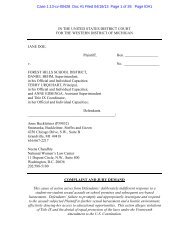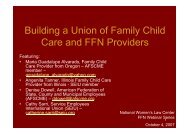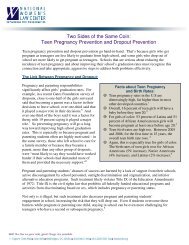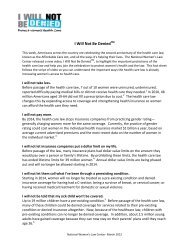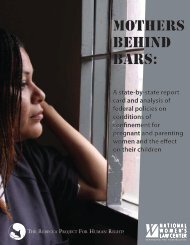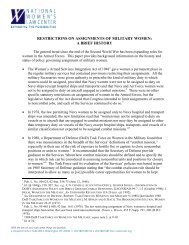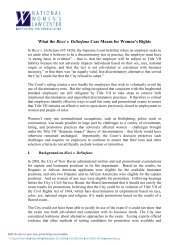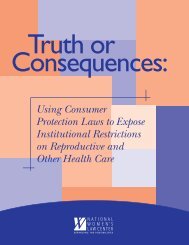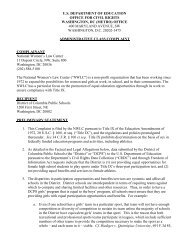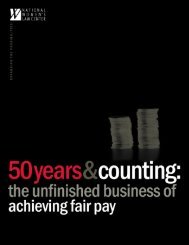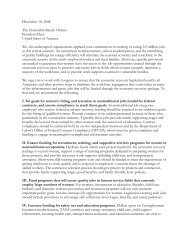The Next Generation of Title IX: Athletics 40 years and counting
The Next Generation of Title IX: Athletics 40 years and counting
The Next Generation of Title IX: Athletics 40 years and counting
Create successful ePaper yourself
Turn your PDF publications into a flip-book with our unique Google optimized e-Paper software.
<strong>Next</strong> <strong>Generation</strong> Issues<br />
What Counts as a Participation Opportunity<br />
for <strong>Title</strong> <strong>IX</strong> Purposes?<br />
Schools are adding competitive cheer <strong>and</strong> flag football for girls in<br />
attempts to demonstrate that they are providing equal opportunities<br />
for girls to play sports. 26 Yet these activities do not provide<br />
female students with the same types <strong>of</strong> competitive opportunities<br />
that male students receive <strong>and</strong> therefore raise <strong>Title</strong> <strong>IX</strong> concerns.<br />
Competitive cheer, which is evolving, currently does not provide<br />
the same level <strong>of</strong> competition or championship opportunities as<br />
TITLE <strong>IX</strong>: ATHLETICS • FACT SHEET<br />
other varsity sports. <strong>The</strong>refore it should not be counted by schools<br />
in their <strong>Title</strong> <strong>IX</strong> athletic participation numbers. 27 And while flag<br />
football is an exciting sport <strong>and</strong> may be easy to add for girls where<br />
a school already has football for boys, the lack <strong>of</strong> opportunities<br />
to play at the college level <strong>and</strong> earn athletic scholarships in flag<br />
football pose <strong>Title</strong> <strong>IX</strong> concerns where schools provide boys with<br />
varsity sports that all provide such opportunities. Questions also<br />
have arisen over whether schools can count indoor track, outdoor<br />
track, <strong>and</strong> cross-country as separate participation opportunities<br />
<strong>and</strong> under what circumstances. 28<br />
1 NATIONAL FEDERATION OF STATE HIGH SCHOOL ASSOCIATIONS, 2010-11 HIGH SCHOOL ATHLETICS PARTICIPATION SURVEY 52 (2011), available at http://www.nfhs.org/content.<br />
aspx?id=3282.<br />
2 Id.<br />
3 Id.<br />
4 DON SABO & PHIL VELIZ, WOMEN’S SPORTS FOUNDATION, GO OUT AND PLAY: YOUTH SPORTS IN AMERICA 14-15, 161 (Oct. 2008), available at http://www.womenssportsfoundation.org/sitecore/content/home/research/articles-<strong>and</strong>-reports/mental-<strong>and</strong>-physical-health/go-out-<strong>and</strong>-play.aspx.<br />
5 See U.S. Dep’t <strong>of</strong> Educ., Office for Civil Rights, Clarification <strong>of</strong> Intercollegiate <strong>Athletics</strong> Policy Guidance: <strong>The</strong> Three-Part Test (Jan. 16, 1996) at 4-5 [hereinafter 1996 Clarification]<br />
(describing case-by-case approach used to determine whether participation opportunities are “substantially proportionate to enrollment rates,” which depends on the size <strong>of</strong> an<br />
institution’s athletic program <strong>and</strong> whether number <strong>of</strong> opportunities that would be required to achieve proportionality would be sufficient to sustain a viable team).<br />
6 <strong>The</strong> number <strong>of</strong> opportunities lost represents the additional number <strong>of</strong> girls who would be able to play sports if the school closed the participation gap. Typical (median) enrollment at<br />
a school with a ten percentage point gap or greater is 1130 students.<br />
7 See 1996 Clarification. <strong>Title</strong> <strong>IX</strong> also requires the equivalent treatment <strong>of</strong> male <strong>and</strong> female athletes <strong>and</strong> the allocation <strong>of</strong> scholarship dollars among male <strong>and</strong> female athletes proportional<br />
to their representation. See generally U.S Dep’t <strong>of</strong> Health, Educ. <strong>and</strong> Welfare, Office for Civil Rights, A Policy Interpretation: <strong>Title</strong> <strong>IX</strong> <strong>and</strong> Intercollegiate <strong>Athletics</strong>, 44 Fed. Reg.<br />
71,413, 71,418 (Dec. 11, 1979).<br />
8 See U.S. Department <strong>of</strong> Health, Education, <strong>and</strong> Welfare, Policy Interpretation, 44 Fed. Reg. at 71419 (1979).<br />
9 Remarks <strong>of</strong> Senator Stevens (R-AL), 130 Cong. Rec. S4601 (daily ed. April 12, 1984).<br />
10 National Collegiate Athletic Association (NCAA), 1981-82—2010-11 NCAA Sports Sponsorship <strong>and</strong> Participation Rates Report 69-70 (October 2011).<br />
11 Id.<br />
12 National Collegiate Athletic Association, 2004-10 Gender-Equity Report 28-36 (January 2012).<br />
13 Id. at 36.<br />
14 See generally Ellen J. Staurowsky et al., Her Life Depends On It II (Women’s Sports Foundation, East Meadow, N.Y.), Dec. 2009, available at http://www.womenssportsfoundation.<br />
org/home/research/articles-<strong>and</strong>-reports/mental-<strong>and</strong>-physical-health/~/media/PDFs/WSF%20Research%20Reports/Her_Life_II_Full.ashx; Dorothy Teegarden, et al., Previous Physical<br />
Activity Relates to Bone Mineral Measures in Young Women, 28 MEDICINE SCIENCE SPORTS EXERCISE 105 (Jan. 1996); Leslie Bernstein et al., Physical Exercise <strong>and</strong> Reduced<br />
Risk <strong>of</strong> Breast Cancer in Young Women, 86 J. NAT’L CANCER INST. 1<strong>40</strong>3 (1994); see also Marilie D. Gammon et al., Does Physical Activity Reduce the Risk <strong>of</strong> Breast Cancer?, 3<br />
MENOPAUSE: J. N. AM. MENOPAUSE SOC’Y 172, Abstract (1996), available at http://journals.lww.com/menopausejournal/Abstract/1996/03030/Does_Physical_Activity_Reduce_<br />
the_Risk_<strong>of</strong>_Breast.9.aspx.<br />
15 Tara Parker-Pope, As Girls Become Women, Sports Pay Dividends, N.Y. TIMES, Feb. 16, 2010, at D5, available at http://www.nytimes.com/2010/02/16/health/16well.htm; Robert<br />
Kaestner <strong>and</strong> Xin Xu, <strong>Title</strong> <strong>IX</strong>, Girls’ Sports Participation, <strong>and</strong> Adult Female Physical Activity <strong>and</strong> Weight, 34 EVAL. REV. 52¬ (2010).<br />
16 Id.<br />
17 See, e.g., Staurowsky et al., supra note 14, at 41, 44; DON SABO ET AL., HIGH SCHOOL ATHLETIC PARTICIPATION AND ADOLESCENT SUICIDE: A NATIONWIDE STUDY, INTERNATIONAL<br />
REVIEW FOR THE SOCIOLOGY OF SPORT (2004) (on file with the Women’s Sports Foundation); G. Nicol<strong>of</strong>f & T.S. Schwenk, Using Exercise to Ward Off Depression, 9 PHYSICIAN<br />
SPORTS MED. 23, 44-58 (1995); R.M. Page & L.A. Tucker, Psychosocial Discomfort <strong>and</strong> Exercise Frequency: An Epidemiological Study <strong>of</strong> Adolescents, 29 ADOLESCENCE 113, 183-<br />
91 (1994) (suggesting that physically active adolescents tend to feel less lonely, shy, <strong>and</strong> hopeless as compared to their less physically active peers).<br />
18 <strong>The</strong> Case for High School Activities (National Federation <strong>of</strong> State High school Associations, Indianapolis, I.N.), 2011, at 6, available at http://www.nfhs.org/WorkArea/DownloadAsset.<br />
aspx?id=6075.<br />
19 See Staurowsky et al., supra note 14, at 38-39 (“According to one recent study, 10% <strong>of</strong> young adult women with a history <strong>of</strong> extensive sports involvement in high school has a child<br />
outside <strong>of</strong> marriage, while the number is 25% for those who had little or no involvement in high school sports.”); T. Dodge & J. Jaccard, Participation in <strong>Athletics</strong> <strong>and</strong> Female Sexual<br />
Risk Behavior: <strong>The</strong> Evaluation <strong>of</strong> Four Causal Structures, 17 J. ADOLESCENT RES. 42 (2002); Don Sabo et al., WOMEN’S SPORTS FOUNDATION, REPORT: SPORT AND TEEN PREG-<br />
NANCY 5-7 (1998), available at http://www.womenssportsfoundation.org/home/research/articles-<strong>and</strong>-reports/mental-<strong>and</strong>-physical-health/~/media/PDFs/WSF%20Research%20<br />
Reports/Teen_Pregnancy.ashx; THE PRESIDENT’S COUNCIL ON PHYSICAL FITNESS AND SPORTS, PHYSICAL ACTIVITY & SPORT IN THE LIVES OF GIRLS (Spring 1997), available at<br />
http://www.fitness.gov/girlssports.htm.<br />
20 See National Collegiate Athletic Association (NCAA), Graduation Success Rate Report: 1999-2002 Cohorts: Overall Division I (2009), available at http://web1.ncaa.org/app_data/<br />
nH8egsrAggr2009/1_0.pdf; <strong>The</strong> Case for High School Activities (National Federation <strong>of</strong> State High school Associations, Indianapolis, I.N.), 2008, at 7, available at http://www.nfhs.<br />
org/WorkArea/linkit.aspx?LinkIdentifier=id&ItemID=3263 (a state-wide, three-year study by the North Carolina High School Athletic Association found that athletes had higher grade<br />
point averages (by almost a full grade point), lower dropout rates, <strong>and</strong> higher high school graduation rates, than their nonathletic peers); Press Release, University <strong>of</strong> Central Florida,<br />
College <strong>of</strong> Business Administration, UCF Study Looks at Diversity in Campus Leadership, Graduation Rates for Women’s 2004 Sweet 16 College Teams (March 25, 2004), available<br />
at http://www.tidesport.org/Grad%20Rates/2004_Campus_Leadership_Study_for_Women%27s%20BB.pdf (study showing that female athletes in the national basketball tournament<br />
had exceedingly high graduation rates).<br />
11 Dupont Circle NW, Suite 800, Washington, DC 20036 | 202.588.5180 Fax 202.588.5185 | www.nwlc.org



